Uttarakhand’s Furious Himalayan Flood Could Bury India’s Hydropower Program
A treacherous mountain range unleashes a torrent of water, mud, and boulders that was long anticipated and willfully ignored.
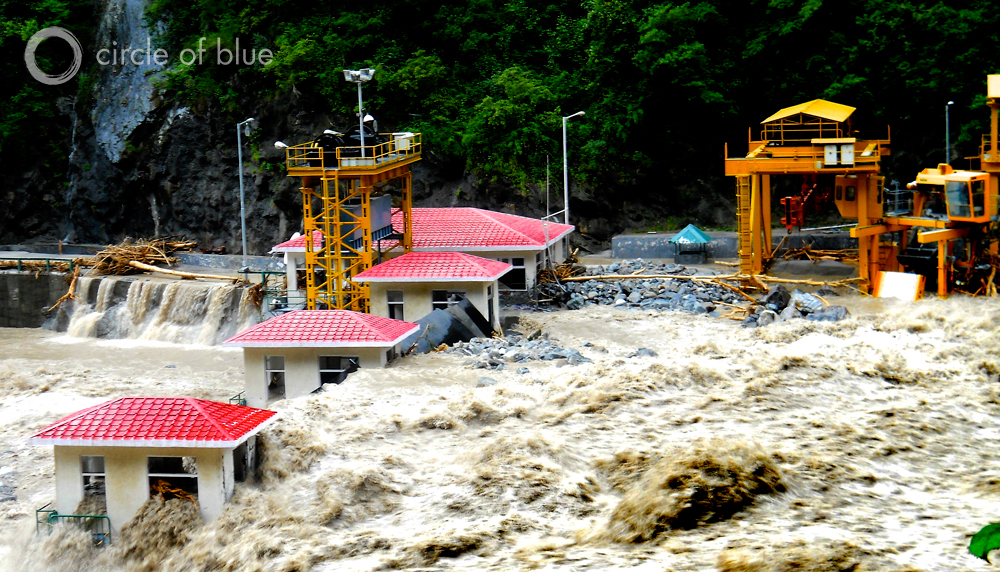
The Uttarakhand flood exceeded every previous high-end boundary of water surge, infrastructure failure, and survivability. At the Vishnuprayag Hydroelectric Project on the Alaknanda River, floodwaters surged over the 55-foot tall dam and boulders buried it in 60 feet of rubble. Photo © By friends of Matu Jansangthan
By Keith Schneider, Circle of Blue
SRINAGAR, Uttarakhand, India – On May 24, 2003, as part a national plan to generate more electricity from sources other than coal, Prime Minister Atal Bihari Vajpayee directed India to pursue one of the most daring energy production campaigns in history.
Vajpayee called on his nation of more than 1 billion people to break through corruption, bureaucracy, and its own doubts and build 162 big hydroelectric power projects by 2025. The dams and power stations would be capable of generating 50,000 megawatts of electricity, the equivalent of 50 big coal or nuclear-fired power plants.
At the time, India’s utility sector had the capacity to generate 108,000 megawatts – one-tenth as much as the electrical sector in the United States. Some 27,000 megawatts, or a quarter of India’s total energy production, came from hydropower.
Vajpayee’s announcement was robed in the formality and national determination comparable to U.S. President John Kennedy’s 1960s plan to land a man on the moon and bring him back safely within a decade. Energy sourced from moving water, Vajpayee said, was desperately needed in a country demoralized by hourly supply disruptions, daily brownouts and regular blackouts.
“Power is a critical input for any economic activity,” the prime minister said. “Its sufficiency is a prerequisite for speeding up India’s economic growth and improving the living standards of all our citizens. Without power, we cannot empower our people in the economic dimension of their lives. It is a major determinant of the quality of life.”
And just like the American space program, not much was discussed in public by the government about the extraordinary risks. Meeting the prime minister’s vision would be technically challenging and extremely dangerous.
Almost all of the new projects — 113 dams and power stations capable of generating 40,000 megawatts of electricity —- were planned for five Himalayan states. Of those, 33 of the new hydropower schemes were targeted for the high mountain valleys in Uttarakhand.
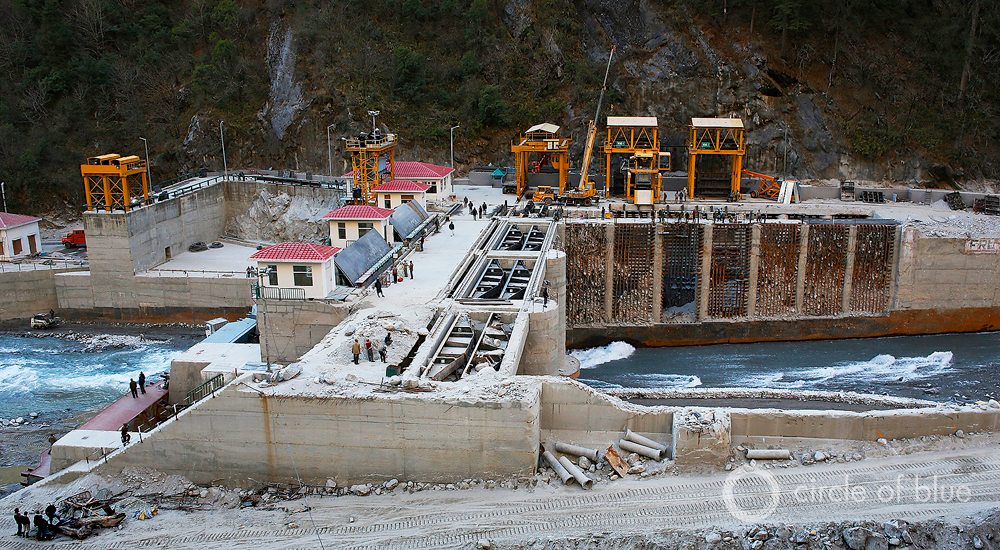
The onslaught of water and boulders battered the Vishnuprayag Hydroelectric Project high up in the Himalayas on the Alaknanda River. Mud and silt still lie in piles on the top of the dam. The cracked and ruptured concrete, and exposed steel reinforcing bars on the dam’s walls, are evidence of the beating the dam took from the Uttarakhand flood in mid-June. Photo © Dhruv Malhotra / Contact Press Images for Circle of Blue
A Himalayan state north of New Delhi that 9 million people call home, Uttarakhand shares borders with China and Nepal. The state, a little smaller than West Virginia, is rich in perpendicular slopes, ample water, turbulent rivers and a history of ecological chaos.
The Mountains Respond
The Himalayas are still forming, still rising — producing one of the most active earthquake zones in the world. The fierce drenching from annual summer monsoons erupt in regular flash floods that undermine the soils of vertical slopes, cause monstrous landslides, and episodically lay waste to big stretches of the region’s serpentine one-way-in, one-way-out highways. In a typical year, dozens of people drown, are buried, or swept away by floods in India’s Himalayan states.
Despite the inherent risks, India’s hydro-entranced prime minister and his aides were determined to join China, Bhutan, Nepal, and Pakistan in turning the Himalayas into the Saudi Arabia of hydroelectric energy. In the decade since 2003, India’s hydropower ambitions magnified: 292 big hydro projects are under construction or planned for India’s Himalayan region, according to the Central Electric Authority.
The most turbulent stretches of many Himalayan rivers are scheduled to support five or six new dams, one every 10 kilometers or so. That’s more utility-scale installations than are planned for the world’s other new hydropower production zones – the Rocky Mountains in British Columbia, the Amazon Basin, and the Andes mountains, according to assessments by power authorities in those regions.
“The government wants to put dams on every river in the Himalayas,” said Prakash Nautiyal, a fisheries biologist and for decades a professor of zoology at the Hemwati Nandan Bahuguna Garhwal University in this Alaknanda River city of 150,000 residents. “You know the car culture of Delhi and Mumbai? Bumper to bumper. That’s what they want to do in the Himalayas with dams. Bumper to bumper.”
The unavoidable challenge that India’s engineers and contractors recognized but largely ignored, according to a flurry of government and university studies dating to the early 1990s, was whether the truculent mountain range would accept such intensive industrial intrusion. Late last spring, at the start of the heaviest monsoon season in memory, the Himalayas answered that question.
On June 16 and June 17, 2013 the mountains unleashed two days of monstrous floods that killed about 6,000 people, according to estimates from the Uttarakhand government. Survivors and researchers at the Wadia Institute for Himalayan Geology put the death toll at 30,000. Some 800 battered bodies were recovered and 5,200 others were declared missing.
India defends the estimated death toll of 6,000 based on the applications it reviewed and approved for compensation to families that lost loved ones.
Residents of the Mandakini River Valley interviewed by Circle of Blue said the number of people who died was much higher, perhaps 30,000. That figure is supported by Kapil Kesarwani, a senior research fellow at the Wadia Institute of Himalayan Geology, a prestigious government-supported research center in Dehradun, Uttarakhand’s capital.
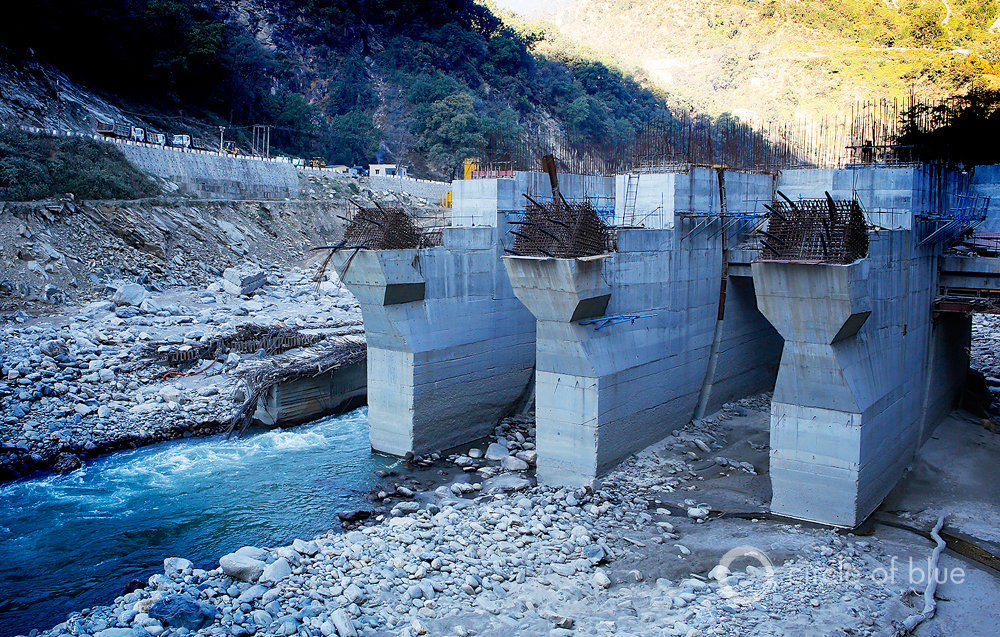
The 99-megawatt Singoli-Bhatwari Hydroelectric Project on the Mandakini River near Okund was so aggressively pummeled by floodwaters and boulders that big chunks of concrete were gouged out of its base and the patches of steel reinforcing rods of two support towers were bent like broken fingers. Photo © Dhruv Malhotra / Contact Press Images for Circle of Blue
The flooding wiped away at least six villages, buried dozens of others in mud, wrecked over 1,000 kilometers of highways, and dumped hundreds of buildings into the furious waters.
Maharaj Pandit, a professor in the Department of Environmental Studies at the University of Delhi, and one of India’s independent authorities on hydropower development, was on a field research trip in mid-June when the rains intensified along the Bhagirathi River near Gangotri, a Hindu sacred site high up in a Himalayan pass.
Pandit heard the grind and crash of boulders knocking against each other in the boiling water. It was a new sound, an alarm signaling urgent danger. He gathered his team, terminated the trip, and descended as quickly as he dared out of the mountains where bridges were washing away and roads were vanishing in landslides.
“I had never seen the river in such a rage,” Pandit said. “The river didn’t feel well that day.”
Flood’s Effects on Dam Construction
The June flood also may have drowned India’s long campaign to diversify its energy production with big Himalayan hydropower projects. Circle of Blue was able to document that the flood seriously damaged at least 10 big projects in operation and under construction in Uttarakhand. Another 19 small hydropower projects that generate under 25 megawatts were destroyed.
The findings are based on Circle of Blue’s field reporting in December and January, state and national media dispatches, independent news services, and trade journal notices. We were assisted by the South Asia Network on Dams, Rivers and People, a non-profit advocacy group, and reports posted on Down to Earth, an online New Delhi-based environmental news site affiliated with the Centre for Science and Environment.
The Central and state government authorities, and private dam developers, have said next to nothing about the extent of the damage in news releases, on their Web sites, or in public statements. Repeated efforts by Circle of Blue to reach business executives and government regulators by email and phone calls were ignored.
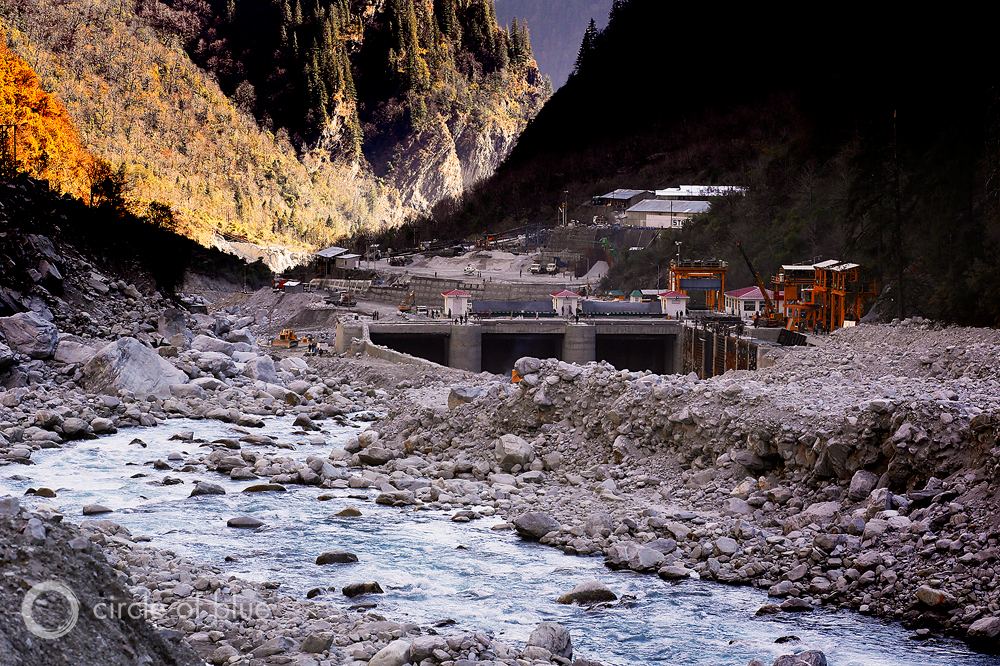
The 400-megawatt Vishnuprayag Hydroelectric Project on the Alaknanda River was buried in mud and boulders, turning its backwater area for water storage into a giant field of dry rubble. It took five months to dig this much of the dam out of the pile of boulders. Photo © Dhruv Malhotra / Contact Press Images for Circle of Blue
The most heavily damaged projects, according to our findings, include:
- The 400-megawatt Vishnuprayag Hydroelectric Project, upriver from Srinagar along the Alaknanda River, was buried beneath 20 meters of rubble that also filled its water storage lake and likely wrecked the mouth of the penstock, the pipe that transports water to the powerhouse downstream.
- A second dam under construction on the Mandakini River, the 76-megawatt Phata-Byung Hydroelectric Project, washed away.
- The 99-megawatt Singoli-Bhatwari Hydroelectric Project downstream on the Mandakini, a major tributary of the Alaknanda, was so aggressively pummeled by boulders that big chunks of concrete were gouged out of its base and the patches of steel reinforcing rods of two support towers were bent like broken fingers.
- The powerhouse and turbines of the 330-megawatt Alaknanda Hydro Power Project in Srinagar were inundated with mud and silt just weeks before it was scheduled to begin operating.
- A landslide blocked the end of the water discharge tunnel at the 280-megawatt Dhauliganga project near the border with Nepal. The plug caused a backup that submerged the entire turbine room constructed deep inside the hill near the dam, causing at least $50 million in damage and a shutdown that has still not ended, said dam operators. (See sidebar for more damaged hydropower projects.)
The Uttarakhand flood surprised India with its fury. Energy authorities in Asia and in North America have said the flood caused the most damage to a nation’s hydropower infrastructure since 1975, when rains from a typhoon overwhelmed the Banqiao Dam and 61 smaller dams in central China, killing 171,000 people.
In the history of energy disasters, the Uttarakhand flood struck the global hydropower industry with the same force that the reactor meltdowns at Three Mile Island (U.S. 1979), Chernobyl (Soviet Union, 1986), and Fukushima (Japan, 2011) battered the nuclear power sector.
“The disaster is a costly wake-up call,” said Peter Bosshard, the policy director at International Rivers, a California based non-profit research and river protection group that primarily operates in Asia, Africa, and Latin America. “It shows that nature will strike back if we disregard the ecological limits of fragile regions like the Himalayas through reckless dam building and other infrastructure development. We can only expect such disasters to happen more frequently under a changing climate.”
Court Intervention
India’s Supreme Court reached essentially the same conclusion. Last August 13, eight weeks after the flood, two Supreme Court judges, ruling in a case involving the 330-megawatt Alaknanda Hydro Power Project, issued an order that indefinitely prohibited the Central and state governments from granting any more permits for hydroelectric projects in Uttarakhand. The order essentially shut down new hydropower development in India’s 27th state.
“We are very much concerned about the mushrooming of a large number of hydroelectric projects in Uttarakhand and its impact on the Alaknanda and Bhagirathi river basins,” wrote Justices K.S. Radhakrishnan and Dipak Misra. “Various studies also indicate that in the upper Ganga area, there are large and small hydropower projects. The cumulative impact of those project components like dams, tunnels, blasting, muck disposal, mining, deforestation, etc. on the ecosystem has yet to be scientifically examined.”
The Supreme Court’s intervention also came with a directive to the Ministry of Environment and Forests, the principal regulatory agency, to form a special commission to study the safety and merits of continuing with constructing dams in India’s most important hydropower state.
The commission, appointed last year, is unlikely to issue its conclusions until after the national election results are announced in mid-May. Those findings, and their implementation, also are likely to be overseen by the National Green Tribunal, a four-year-old panel of senior jurists that rules on India’s big environmental cases.
In August, two weeks after the Supreme Court order, the Tribunal said it would hear a case involving flood damage that citizens in Srinagar said was amplified by the Alaknanda hydropower dam. The Tribunal also is monitoring repairs and construction at the damaged Vishnuprayag dam. The Tribunal’s presence is a clear indication that its jurists will closely follow other legal and regulatory aspects of the disaster.
“The Uttarakhand disaster has shown how operating and under construction hydropower projects can increase the vulnerability of the already disaster-vulnerable area,” said Himanshu Thakkar, coordinator of the South Asia Network on Dams, Rivers and People. “That hydropower projects are not clean, green, cheap and renewable source of energy was known to any discerning observer. The disaster has only strengthened that case. It has shown how much more careful we need to be before taking up any more such projects. If we do not learn these lessons, the price is going to keep climbing. These lessons, incidentally, are valid across the Himalayas, not just for Uttarakhand.”
A Long History of Water-Powered Electricity
India’s experience with hydroelectric energy is among the longest in the world. In 1897, just two years after the world’s first hydroelectric power station opened at Niagara Falls, in the United States, British engineers built the 130-kilowatt Sidrapong Power Station near Darjeeling, in northeast India near the border with Bhutan. It was India’s first water-powered electrical generating plant.
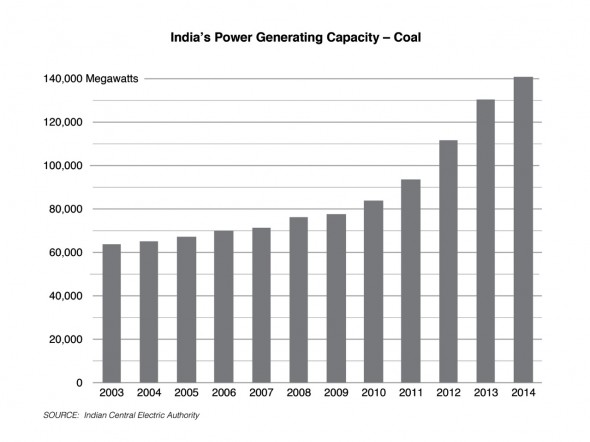 |
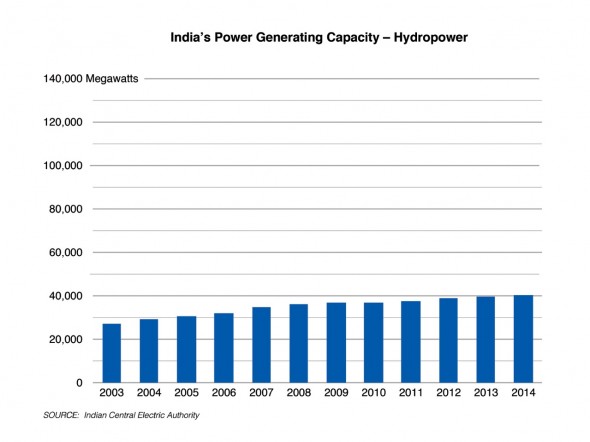 |
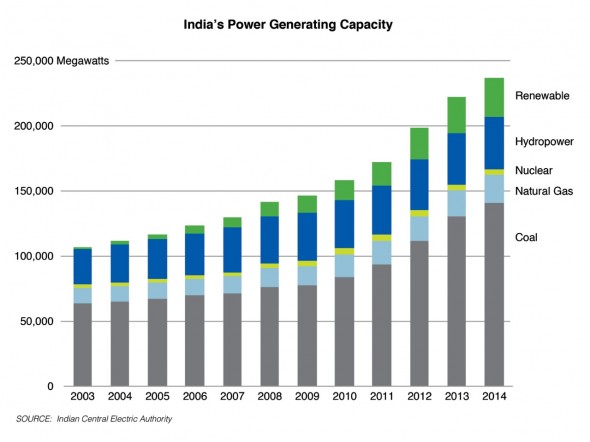 |
|
Graphics by Erin Aigner for Circle of Blue
India’s power generation: Hydropower, coal, and total generating capacity.. Click images to enlarge.
|
||
In 1947, when India gained its independence, 508 megawatts of the country’s 1,362 megawatts of electrical generating capacity were gained from hydropower, or 37 percent. Most of the remaining 756 megawatts of generating capacity, or 55 percent, came from coal combustion.
Jawaharlal Nehru, India’s prime minster from 1947 to 1964, encouraged dam construction as a symbol of modernization and rapid industrialization. The Hirakud Dam, completed in 1957 along the Mahanadi River in eastern India, has 307.5 megawatts of generating capacity and is one of the longest dams in the world.
Nehru was enthralled by the 225.5-meter (740 feet) Bhakra Nangal dam in Himachal Pradesh, for decades India’s tallest dam. During a visit to the dam in 1956, one of 10 he made to view construction and to dedicate the dam in 1963, Nehru declared, “Bhakra, the new temple of resurgent India, is the symbol of India’s progress.”
Yet building dams at the pace India’s government long sought proved elusive. It wasn’t that India’s leadership lacked resolve. In the 1970s, India established the National Hydroelectric Power Corporation to focus the national government’s technical and financial attention on building hydroelectric dams. Between 1975, when the agency was founded, and 1985, water-generated electricity capacity grew to 14,460 megawatts, almost 7,500 megawatts more than when the new agency was formed. Still, hydropower fell to less than 30 percent of the country’s generating capacity.
Not satisfied, India’s energy and finance authorities approved a more aggressive hydropower development policy, approving a new Electricity Act in 1998 that led in 2003 to an updated law and Prime Minister Vajpayee’s hydropower initiative. Both were established as India was opening its economy to foreign investors and as its leaders eyed the energy-sucking whirlwind in neighboring China as an economic growth model to emulate.
The Central Electric Authority estimated that 50,000 new megawatts was just a third of India’s potential hydropower generating capacity of 150,000 megawatts, more than all but three other nations – China, Brazil and Canada.
New financing, subsidies, and permitting protocols were established to encourage the construction. India’s prime minister and The Ministry of Power, the energy development agency, promoted the idea that hydropower would account for 40 percent of India’s total generating capacity. On paper, and in the glare of intense media attention, the development plan seemed ambitious but achievable.
Uttarakhand – Land of Big Water Projects
More than half of the hydropower generating capacity announced in 2003 was to come from just two states. Uttarakhand, then named Uttaranchal until it became India’s 27th state, was the focus of 33 projects and 5,282 megawatts of generating capacity. Arunachal Pradesh, which borders China, Bhutan, and Myanmar in India’s Northeast region, was set for 42 projects and 27,293 megawatts.
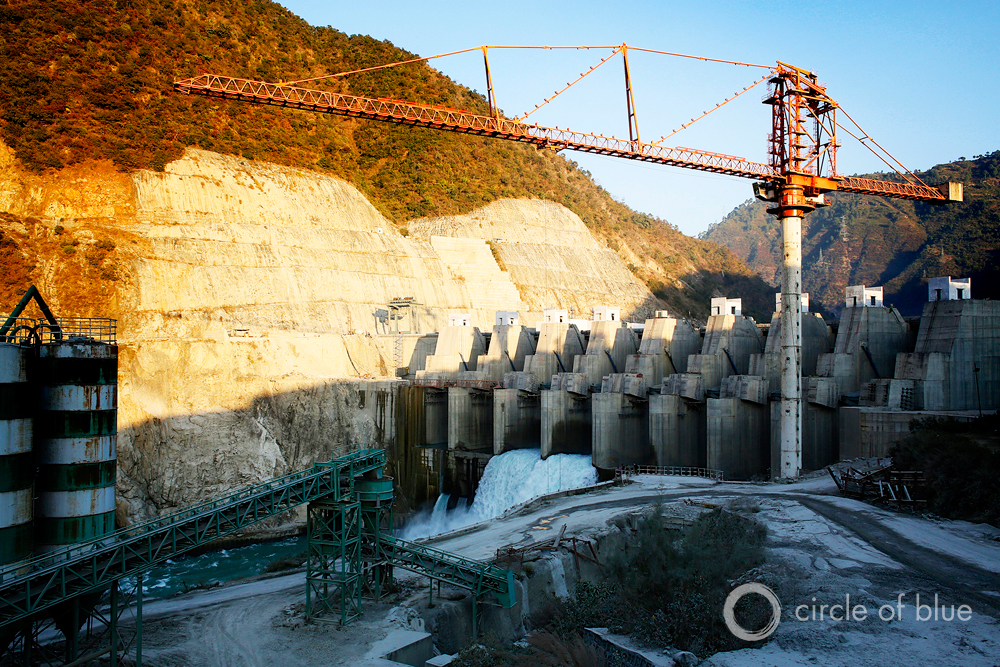
The 330-megawatt Alaknanda Hydro Power Project, commissioned in March in Srinagar, is the newest of Uttarakhand’s big hydroelectric projects. Five more are under construction. More than two dozen big hydropower dams and generating stations are planned for the tight Himalayan valleys in Uttarakhand and its swift and turbulent rivers. Photo © Dhruv Malhotra / Contact Press Images for Circle of Blue
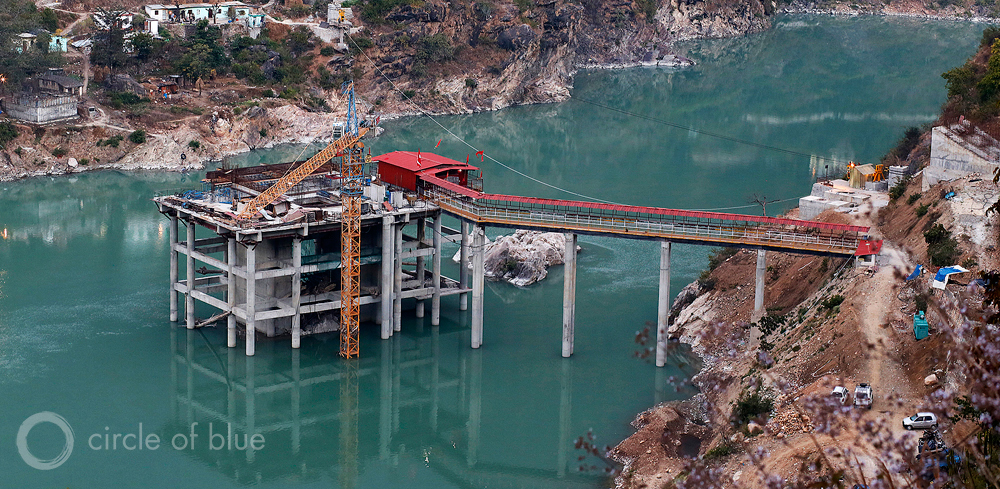
North of Srinagar, the lake filling up behind the new Alaknanda hydropower dam required the owners to build a concrete platform high enough to keep Dhari, the goddess of power, dry. Dhari is named for an Alaknanda River village and is a noted Hindu shrine. On the day that Dhari was placed on the new platform, June 16, the cloudburst opened on the Himalayan ridges above the Alaknanda and Mandakini rivers, setting off the calamitous flood. Photo © Dhruv Malhotra / Contact Press Images for Circle of Blue
The first four years of the hydropower expansion, 2003 through 2006, went well. Generating capacity nationally jumped sharply to 34,654 megawatts, an increase of 7,654 megawatts in capacity. That was close to the 11,000 megawatts of new generating capacity from coal-fired power plants during the same period.
Uttarakhand emerged as the most important state for new dams and power stations. In 2005 and 2006, three big hydropower facilities opened, with generating capacity of 1,680 megawatts, or more than a fifth of the country’s new hydro capacity.
But the years from 2007 to 2013 were much more difficult for India’s hydroelectric construction sector. Generating capacity rose to 39,941 megawatts by the end of March 2013, an increase of 5,287 megawatts in six years, or less than 1,000 megawatts of new generating capacity annually. During the same six-year period, India’s overall generating capacity from utilities grew to 223,343 megawatts — a 90,000-megawatt jump, driven principally by 60,000 megawatts of new coal-fired generating capacity.
The causes of the slowdown in hydropower development are numerous, according to assessments by the Central Electric Authority, the Ministry of Power, engineering studies and hydro trade association journals. The difficulty in securing financing for projects that typically range from a low end of $500 million to well over $1 billion, and to move proposals through India’s suffocating permitting bureaucracy, added time and expense. The size of the projects, the extent of land needed for water storage, the numbers of people to be moved, along with the considerable harm to fisheries and local ecology, generated a fierce civic opposition movement, particularly in Uttarakhand and in Arunachal Pradesh.
Then came the forbidding technical difficulties of building and operating big hydroelectric schemes in the Himalayas. They baffled engineers and managers. Constructing a big dam in the Himalayas, it turned out, was as difficult a feat of engineering, design, construction, and industrial management as exists on the planet.
Flash floods wrecked construction schedules and added costs. Landslides buried equipment. It has taken years for engineers and designers to fully understand and deal with the exceptionally high concentrations of mud, silt, and grit carried by Himalayan rivers. The load of ragged-edged grains of quartz and feldspar constantly overwhelm settling basins, and chew up pipes and turbines.
Stories of epic episodes of engineering and construction have become part of the Himalayan narrative. In Himachal Pradesh, west of Uttarakhand, the owners of the 1500-megawatt Nathpa Jhakri Power scheme on the Satluj River finally opened six generating turbines in 2004 after 11 years of construction.
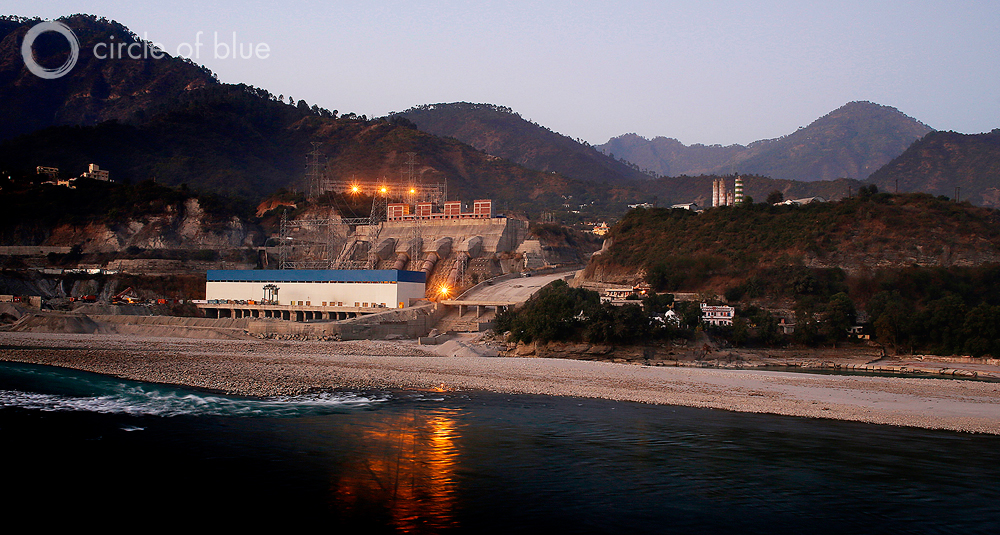
The June flood inundated the power station of the 330-megawatt Alaknanda Hydro Power Project in Srinagar. Turbines inside filled with mud and grit. The project on the Alaknanda River was commissioned in March, 2014, months later than the scheduled opening in October 2013. Photo © Dhruv Malhotra / Contact Press Images for Circle of Blue
The project was a study in Job-like calamity and persistence. In 1993, just as construction began, a rockslide caused by the monsoon demolished the construction site. Flash floods struck in 2000. In its first years of operation so much silt clogged the dam’s power turbines that the plant was shut down for weeks at a time. New coatings on metal parts, an increase in the height of the dam, and revised operating procedures have helped since.
India’s power authorities and engineers insist they recognize and can manage the risks. Hydropower sector executives say opponents of dam construction are exaggerating the potential harm.
“There has been considerable environmental awakening in India during the past 25 or so years,” wrote Chetan Pandit, a hydropower specialist and former official in India’s Central Water Commission, in an email to Circle of Blue. “We did realize that there was a need and scope to improve the performance of our river valley projects on environmental and social counts. India responded to this requirement by enacting several laws and rules that stipulated an exacting scrutiny of the project design before it was granted environmental clearance. This was a welcome move. But the downside of it was, some enterprising young people saw in this an opportunity to earn a livelihood by opposing all infrastructure, and that includes river valley projects.”
Warnings Ignored
Concern about the safety of the new Himalayan dams didn’t come just from uninformed opponents. In 1996, a report on the Himalaya’s changing ecology by the Center for Science and Environment, the New Delhi-based research group, said: “The Himalayan mountains constitute an ecological system naturally primed for disaster. The deep gorges through which the Himalayan rivers flow convey the impression that the Himalayan valleys would never face floods. Yet these very channels often fail to contain the fury of disastrous floods. Among the most affected valleys are the Alaknanda and Bhagirathi valleys of the Garhwal Himalaya.”
In 2007, the United Nations Intergovernmental Panel on Climate Change noted that the Himalayas were among the regions most affected by the warming atmosphere, a point supported two years later by India’s Ministry of Environment and Forests.
A 2009 report on the risk of floods in Uttarakhand by India’s Comptroller and Auditor General warned that “audit scrutiny of project records revealed that no specific measures had been planned/designed in any project to cope with the risk of flash floods. The adverse consequences of such floods are acute as they cannot only damage the project structures, but can cause loss of life in low-lying downstream areas.”
In 2012, a study commissioned by the Ministry of Environment and Forests recommended that 24 of 39 hydropower projects proposed for Uttarakhand be suspended because of the havoc they would cause for fisheries, and the region’s environment. The Ministry did not act on the recommendation.
That same year, Uttarakhand’s own Disaster Management Department finished a report that documented the causes and aftermath of a flash flood in the upper reaches of the Bhagirathi River. The disaster, on August 3-4, 2012, was a virtual dress rehearsal for the much bigger flood 10 months later.
Like the 2013 flood, the Bhagirathi flood was triggered by a big monsoon cloudburst. The raging waters and landslides killed 35 people. The highway and mountain road network in the Bhagirathi basin was heavily damaged and thousands of people were stranded for weeks.
The authors of the government report found “widespread devastation in the district and even the district headquarters was not spared by the fury of nature. Heavy precipitation and ensuing flash flood resulted in washing off of a number of vehicular and pedestrian bridges.”
No official heed was paid to these and other studies that clarified hazards from floods and landslides. Instead, the Central Government and Uttarakhand authorities ardently pursued construction of big dams with generating capacity above 25 megawatts, and of many more small dams that generated less than 25 megawatts.
In 2008, the 304-megawatt Maneri Bhalli II project opened on the Bhagarithi River, more than halfway up the turbulent course to its source in the Himalayas.
In 2012, the 400-megawatt Koteshwar project, featuring a 97-meter tall (318 feet) concrete dam, opened on the Bhagarithi River, 22 kilometers (14 miles) downstream from the 1,000-megawatt Tehri Dam, which opened in 2006 and, at 260 meters (855 feet), is India’s tallest dam.
Of the 7,200 megawatts of new hydro generating capacity that India developed from 2006 to 2013, 2,384 megawatts was opened in Uttarakhand, or 32 percent. Of the 21 big hydropower stations commissioned in India since 2006, five opened in Uttarakhand. A sixth big project, the 330-megawatt Alaknanda Hydro Power Project here opened on March 5, 2014, six months after its scheduled start. The June 2013 flood inundated its power station and jammed the turbines with muck.
Uttarakhand also is the site of India’s most aggressive plan for future hydropower development. Five other big dams and 35 projects fewer than 25 megawatts each are under construction. If completed, they’ll add 1,866 megawatts of capacity from large dams, and 180 megawatts from small projects. Moreover, India’s newest Five-Year plan (2012 – 2017) for energy development urges Uttarakhand to build 24 more big dams by 2017 to generate 6,858 megawatts of electricity.
In short, before the flood, Uttarakhand’s hydroelectric development program was rivaled in Asia only by China’s Himalayan provinces.
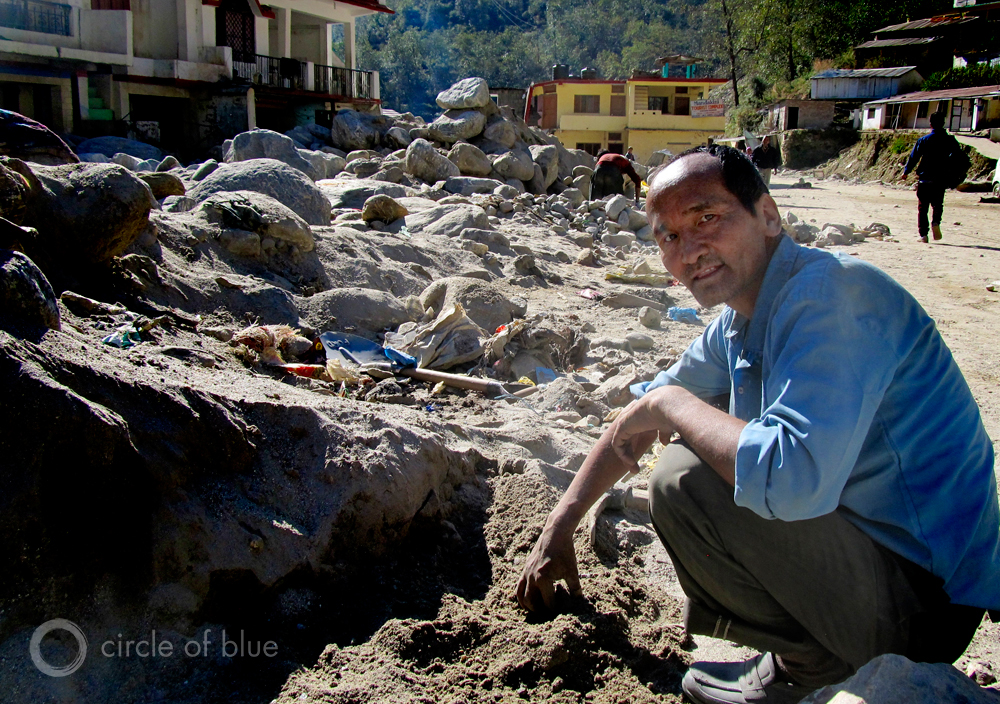
Sonprayag, a tourist village just downstream from the Kedarnath shrine, was swept nearly clean away by flood waters and boulders. More than 500 cars were carried into the Mandakini River. At least 25 people who were hiking down from Kedarnath and crossing a hillside just upriver were buried when it slipped into the river. Click image to enlarge. Photo © Keith Schneider / Circle of Blue
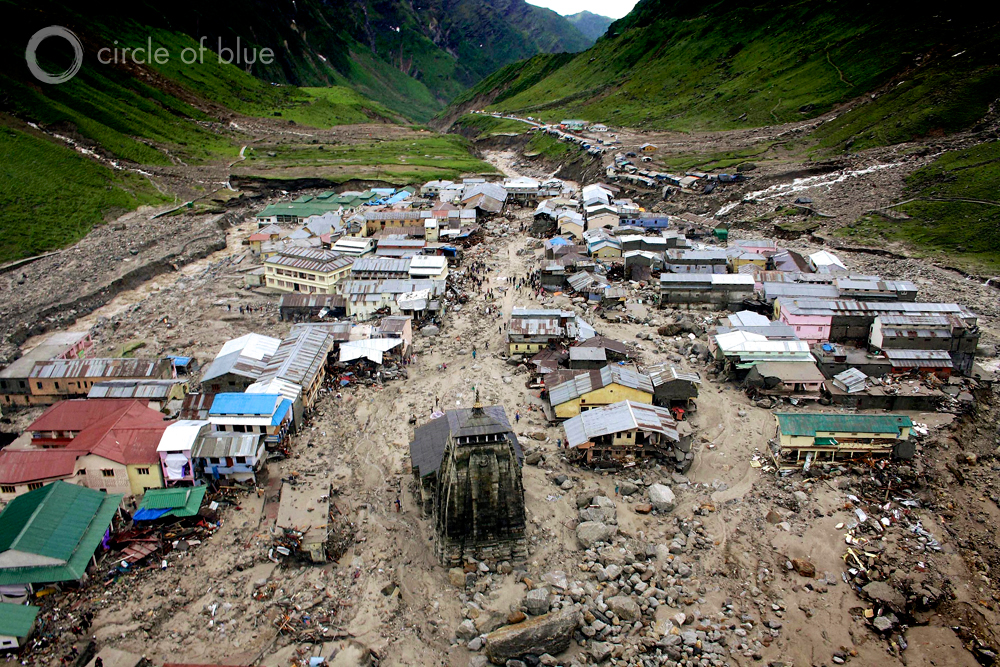
The floods on June 16 and 17 tore through Kedarnath, a sacred Hindu site high in the Himalayas. Hundreds of buiidngs in the Mandakini River floodplain were washed away. The Kedarnath temple survived, guarded by a big trailer-size boulder that washed down the mountain and lodged in front, directing flood waters and boulders around the 1,200-year-old shrine. Photo © www.tehelka.com
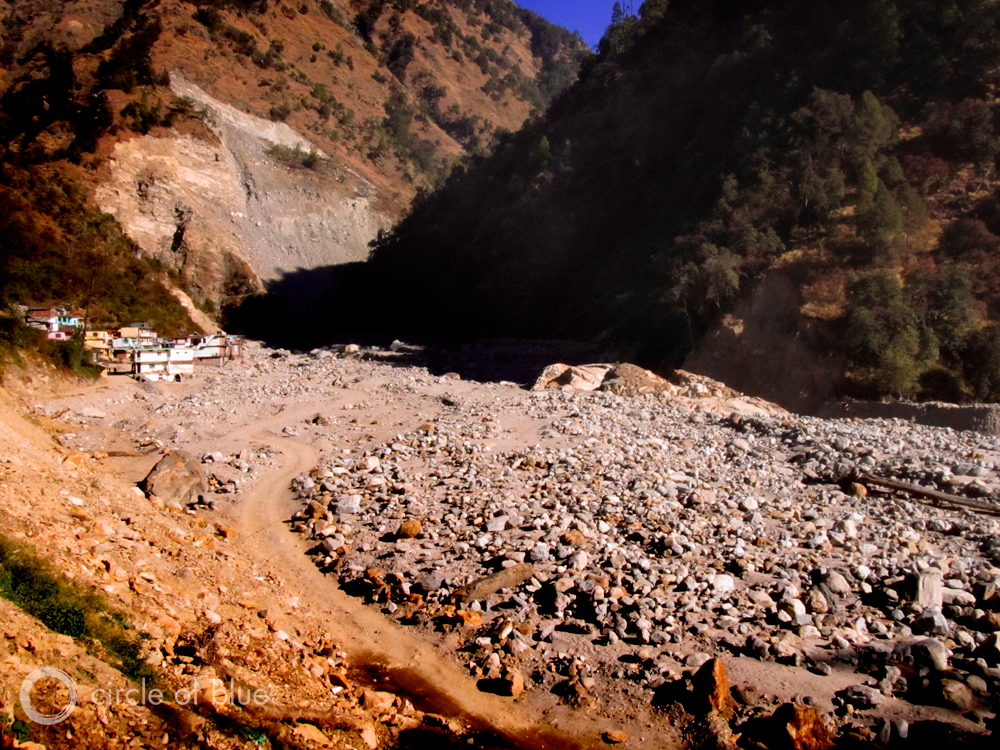
Most of Sonprayag, on the Mandakini River, was destroyed by the June flood. What’s left of Sonprayag now sits directly on the Mandakini’s banks. The riverbed is a new geography of immense boulders that survivors said is 250 feet higher than the channel where the river ran before the flood. Photo © Keith Schneider / Circle of Blue
Whether that remains the state of hydro affairs is not at all secure. There are five big dams under construction in Uttarakhand. It’s unclear if those facilities will be commissioned. A storm of bureaucratic decision making, financial shortfalls, engineering challenges, and the Supreme Court’s expert commission findings can be drawn into a convincing case that India won’t meet its ambitious timeline in Uttarakhand, or in the other Himalayan states.
“The Supreme Court of India ordered the Ministry of Environment and Forests to constitute an expert committee to re-examine certain environmental aspects of the hydro power projects in Uttarakhand, including to examine whether the hydro power projects in any way contributed to the floods,” said Chetan Pandit in an email. “Pending the report by this committee, the court has put a ban on giving further environmental clearances, which has affected 24 ongoing projects. Whether these projects will survive, or whether these will be terminated, will depend to a great extent on the report this committee submits.”
The Supreme Court’s intervention exemplifies the intensifying and conflicting response to the Uttarakhand disaster by India’s political infrastructure. On January 31, 2014, Uttarakhand Chief Minister Vijay Bahugunah resigned at the insistence of his Congress Party leadership, who said his inept management of the rescue and relief operations was unacceptable.
A month before, in December 2013, Jayanthi Natarajan resigned under pressure as head of the Ministry of Environment and Forests. India’s senior leadership, according to press accounts, were dismayed by the slow pace for reviewing and approving permits for big industrial projects, including for hydroelectric schemes. She was replaced by Veerappa Moily, a senior leader of the Oil and Petroleum Ministry, and a proponent of hydroelectric development.
In interviews, high government officials said they anticipated that neither the Uttarakhand disaster, nor the findings of the Ministry of Environment and Forests study commission, would significantly alter India’s strategy of aggressive Himalayan hydropower development. H.L. Bajaj, the former chairman of the Central Electric Authority, said the risks of India’s hydropower strategy are worth the gain of securing more electricity. “Perhaps we will make adjustments to designing hydro schemes,” Bajaj said in an interview in his New Delhi office. “I don’t foresee that India will stop building these projects.”
Ram Prasad Lal, a director in the India Meteorological Department, asserted that until the June flood — what he called a “100-year event” — hydro schemes had proved resilient to heavy Himalayan rainfall. Opponents to Himalayan hydropower dams questioned that view. They said that the numbers of dams being washed out of high Himalayan valleys is increasing. Floods in Nepal in 1981 and 1985 destroyed new hydroelectric projects. Two dams were lost in a 1982 flood in Bhutan. Two more dams washed away in Arunachal Pradesh in the last decade, according to Partha Jyoti Das, programme head at Aaaranyak, a science research organization in Guwahati, and co-author of an influential report on the hazards of Himalayan hydropower projects. “It’s becoming more common in this region. People just don’t hear about these disasters,” said Das.
Nine months after the Uttarakhand disaster, India’s regulatory and power development agencies ardently pursue construction, permits, and financing for more big hydro projects in four other Himalayan states, and for at least two projects in Bhutan. One hydro scheme under construction since 2007, the 330-megawatt Kishanganga Hydroelectric Project on the Kishanganga River in Jammu and Kashmir, prompted a dispute with Pakistan, which is concerned about the water diverted from the river for generating power.
Pakistan brought a case to the Hague’s Permanent Court of Arbitration, which ruled last year that India was entitled to just a minimal flow for electricity. How that ruling affects India’s relationship with Pakistan, or the generating capacity of a project due to be completed in 2016, is a new facet of the ecological and diplomatic tumult India’s hydropower strategy is now generating.
More Seasons of Menace
In December and January, the dry season in Uttarakhand, the Alaknanda and Mandakini Rivers are clear and blue with no angry crest at all. Yet both rivers, and several more affected by the June flood, reflect the grimness of what happened, and the strain of what could easily happen again later this year.
The road transport network is not fully repaired. Transportation is so difficult, newspapers reported in December, that 1,200 tons of food could not be distributed and rotted in place. Hundreds of people are homeless.
The gathering danger is not close to being lifted from Uttarakhand’s magnificent and hardened Himalayan valleys. So much silt and mud and boulders washed off the hillsides during the June 2013 flood that they filled the riverbeds. The rivers of the Alaknanda and Bhaghirati basin run now on new bottoms that are 5 to 35 meters higher than they were before the flood, according to residents and the Geological Survey of India.
That means that unless rubble is removed, which amounts to a monumental and costly excavation project that has not started, the approaching 2014 monsoon this summer will easily overflow river banks and could cause more terrible flood damage to dams and to communities. The Himalayas, like a daredevil avenger, is exacting its vengeance with lingering seasons of menace.
Circle of Blue’s senior editor and chief correspondent based in Traverse City, Michigan. He has reported on the contest for energy, food, and water in the era of climate change from six continents. Contact
Keith Schneider

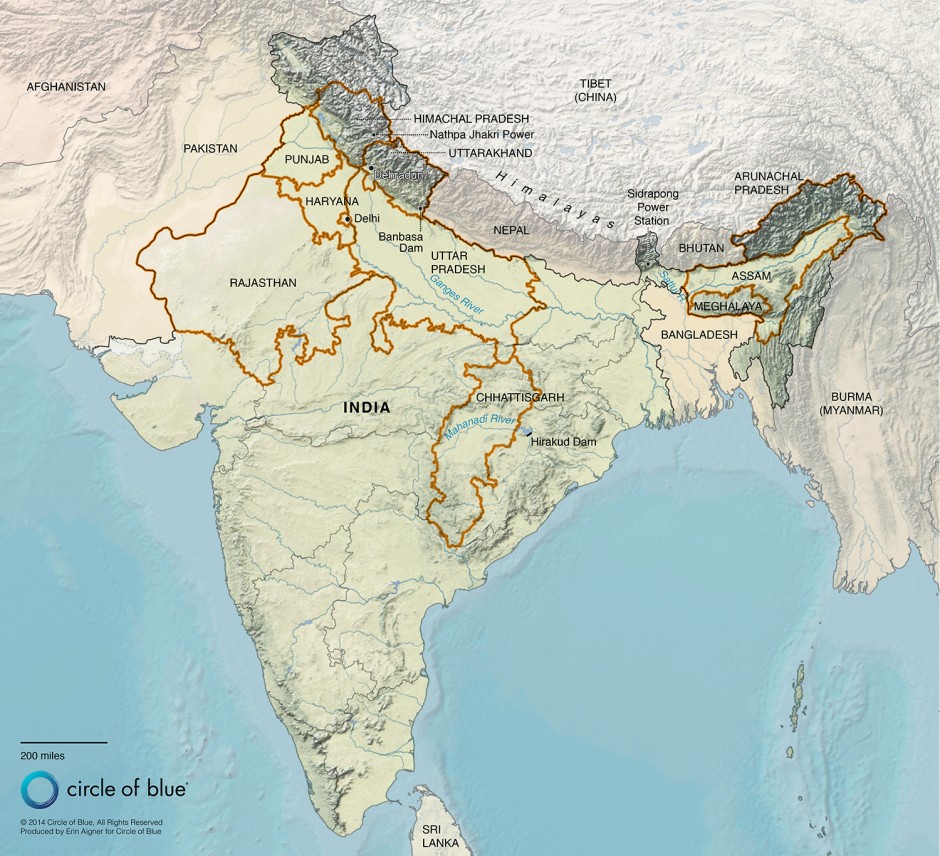
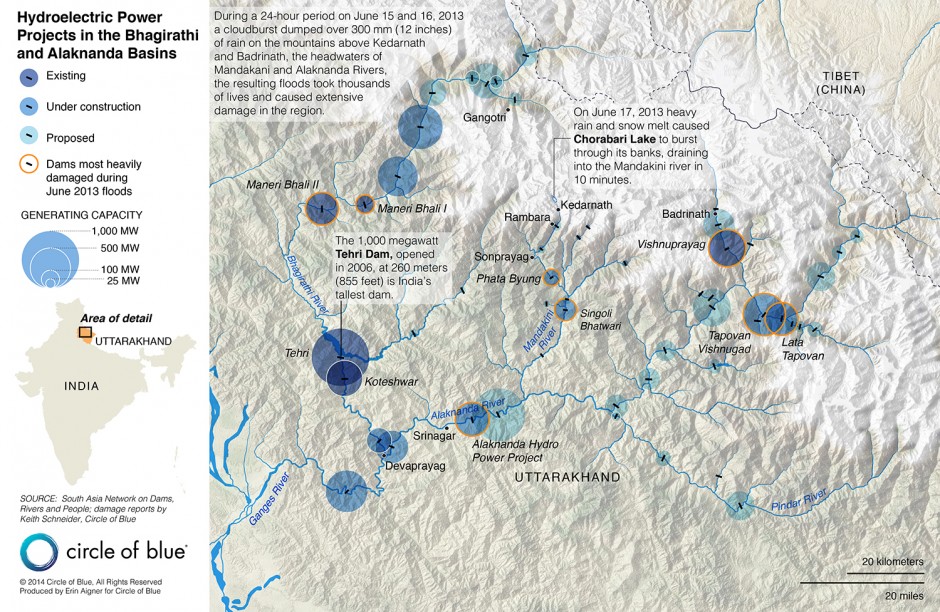
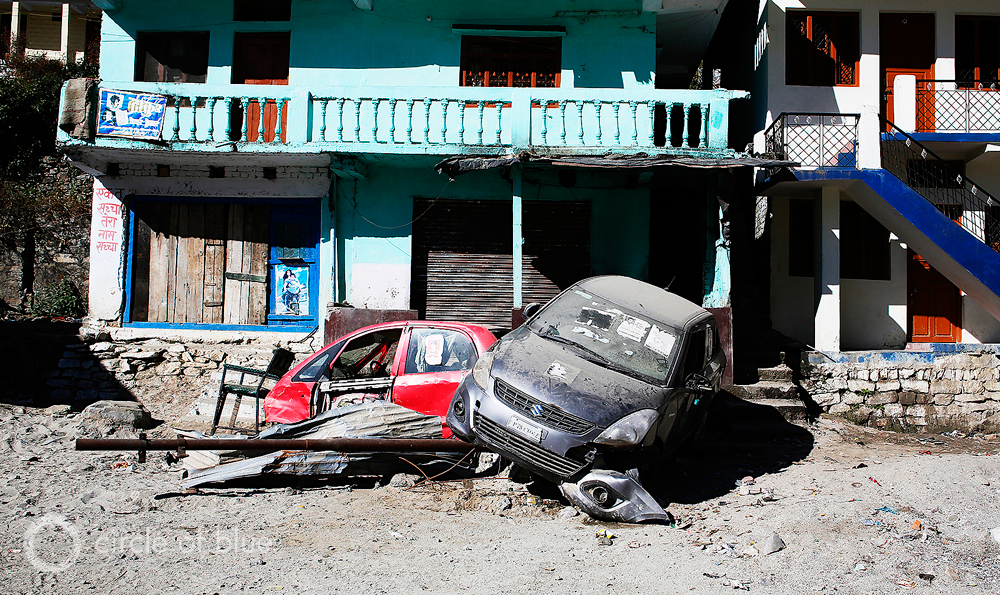
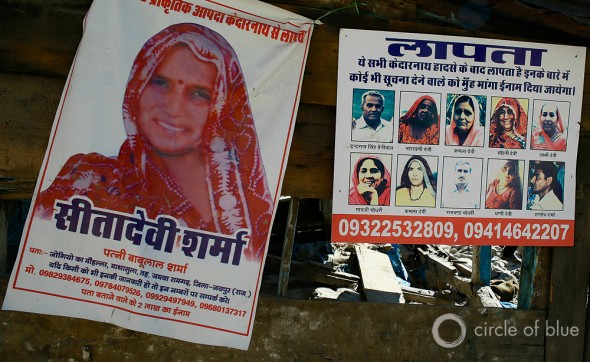
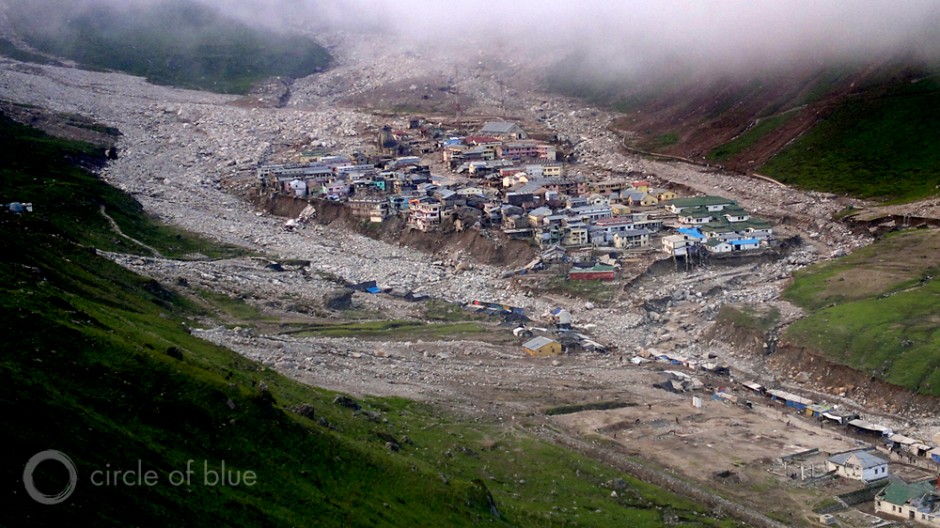
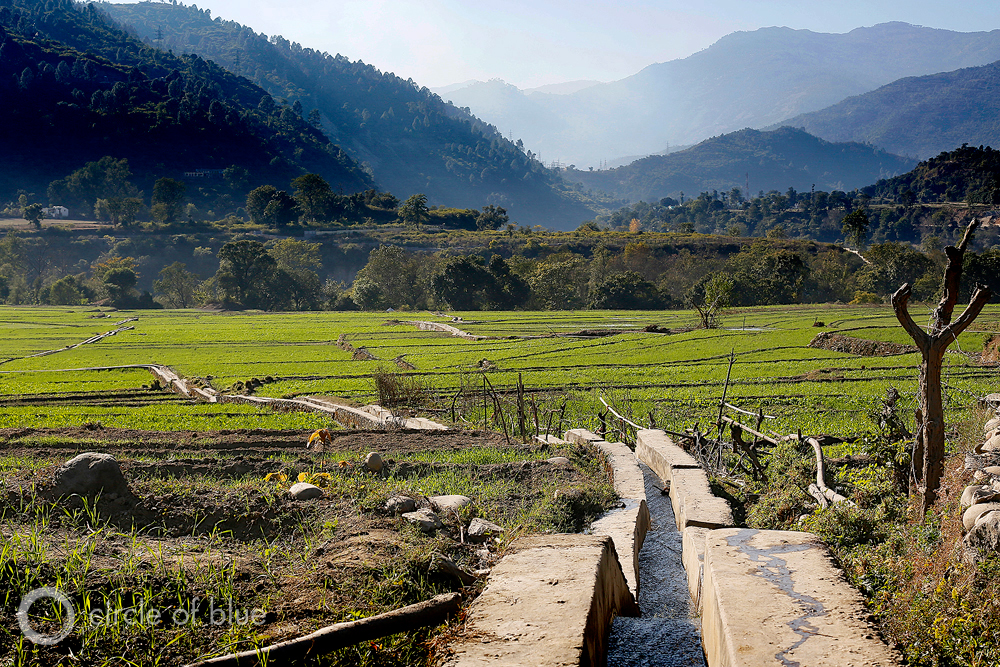
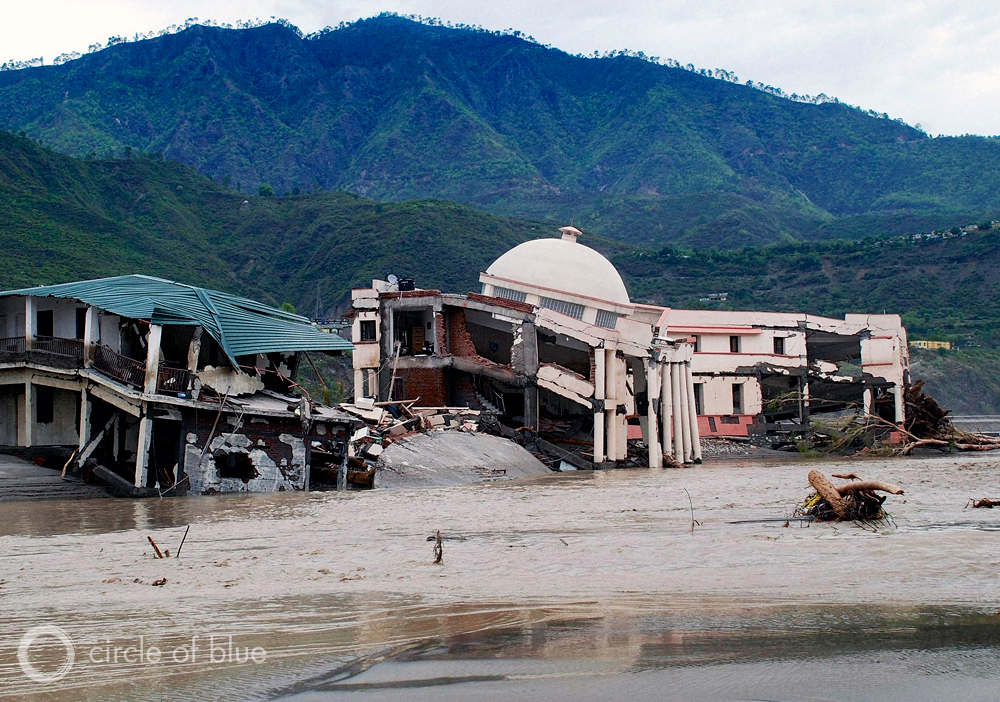

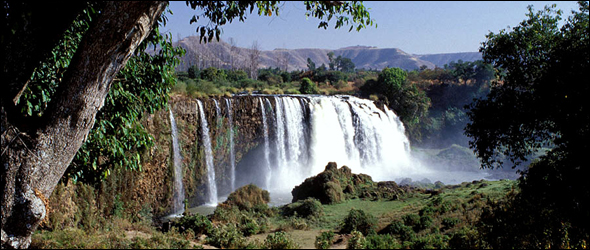
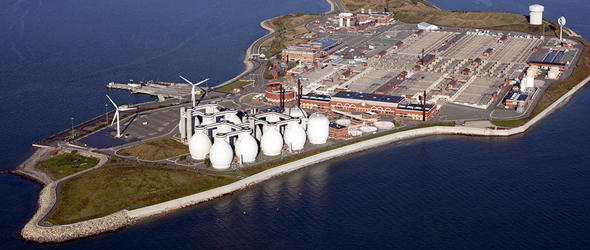
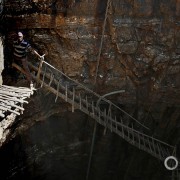
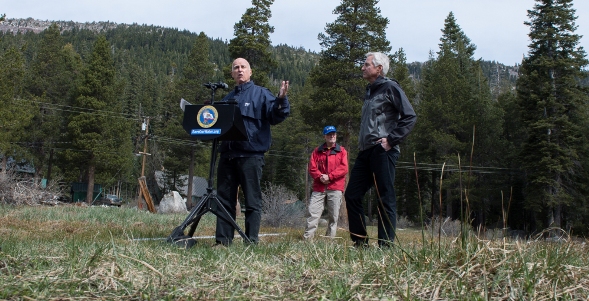
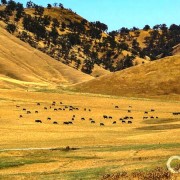
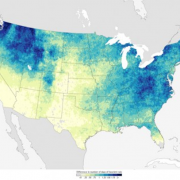



The results are not unexpected given the lack of hydroecological analysis and environmental planning at the watershed level. Future predictive models for this region using the same data will provide more accurate estimates of future conditions relative to changed landscapes and climate conditions.
There is no doubt that the recent disaster caused some damage to the power projects. But no where in the text, it is proved that the cause of the disaster was Hydropower. Damage caused to the other infrastructure was in fact much more as compared to the Hydropower in infrastructure.
I am surprised to see that the suggestive policy intervention is like “Kill the diseased then curing the disease”. If this is how the solution to a problem is made then why not to remove all the doctors and let the diseased persons be removed from the society.
Almost all the figures mentioned in support of consequences of disaster is personal communication and not collected through scientific investigation. To my knowledge and experience of working with the rivers and developmental projects in the Alaknanda and Bgagirathi basin, I wish someone should be sensitive enough before quoting figures.
It will be nice to hear a solution at the end of such write up. If siltation caused flood, and the silt is being dumped by the Hydropower agencies …then the problem is with Dumping and not with the Hydropower. There are Developers who are certainly not careful about environment. Punish them …use proper management strategies,….do what ever is required to protect environement. But, simply blaming Hydropower linking it with Dams is incorrect. There are several designs of Hydropower which can actually take care of ill effects of a Dam. In this connection one should rely on scientific data sets then hypothetical individual views.
Wish, the author in next write up will put more balanced view then biased one.
There are two types of dams that dominate on the glacially fed rivers of the Uttarakhand, Indian Himalaya. The first are the small run of river projects that do not really have a substantial dam or reservoir. The second are the larger projects which have large reservoirs, such as Tehri Dam. Tehri has a reservoir substantial enough to limit downstream flooding and to not be affected by such floods. The run of river dams do not alter the flood hydrograph, and do not enhance flood anger, but of course can be easily damaged. The overall cost of each is small. They are a good investment since without a reservoir they do not displace people and provide power. The long term economics has to consider the high level of repair they are likely to require.
The role of glaciers and how glaciers are documented for
Ratangrian Glacier
Khatling Glacier
Jaundhar Barak
Chorobari Glacier
Excellent article Kevin. In supplying electricity to such a huge population something has to give but after seeing the eyesores of hydro construction on the Parvati, Sutlej and Pindari rivers I can understand the wrath of the Gods of Uttarakhand. It takes a lot of skill to bring one of these projects to completion, perhaps a more respectful attitude to the awesome power of nature can avert/limit future damage to infrastructure. That was a great shot of the boulder protecting the Kedarnath temple.
Good work, regards